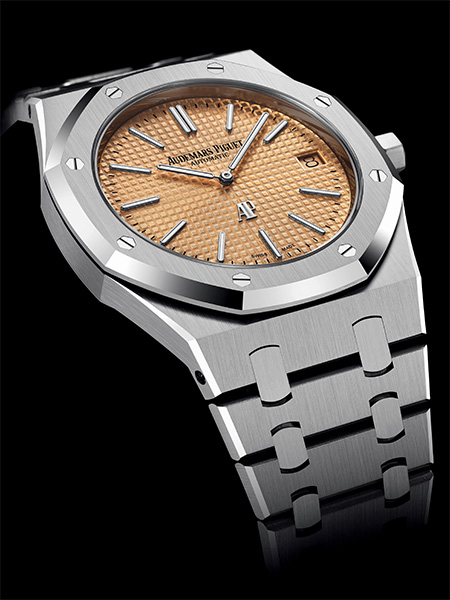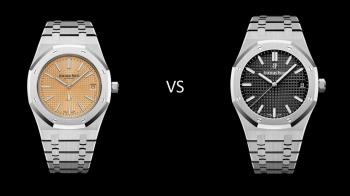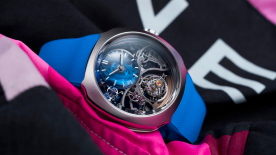So that’s it, he’s gone. He had been an icon of fashion for decades. He was able to create and recreate himself. Almost everyone knew him, sometimes even beyond his creations. He was an inventive genius but also a public person who created an image for himself, to the point of becoming a “product” himself. A look, an accent, carefully placed studs. Whether you like him or not, Karl Lagerfeld was a monument.
What is interesting about fashion is the power of image. Fashion designers often succeed by becoming part of the inventions that spring from their minds. Their name is their brand, or perhaps we should say their brand is their name. They could never be discreet, even if they wanted to. Their names are everywhere. On dresses, T-shirts, labels, even on the paper bags or credit card receipts that you get when you buy their creations.
The designer is everywhere.
In the watch industry, things are totally different.
Because the history of watches does not come from appearance, but from utility. For a long time, the watch was a technically useful object. Its image was created by functionality. A watch was above all an ensemble of components like pushers, crowns, cases and straps. And a movement, of course. When put together, we had a functional object.
But little by little, design started to become more important. Not by… design, but as a consequence of functionality. Let’s take some iconic watches as examples. The Rolex Submariner is a watch that everyone recognises. A black bezel, a simple dial, a special typography, strange hands and a functional bracelet. There’s nothing particularly exceptional there, but when you put everything together you get a watch that everyone knows and everyone wants. Whether or not you are a diver is irrelevant. This watch transcends its raison d’être, and its image and design have become detached from its initial vocation.
So this begs the question: who designed the Submariner? I’m not enough of an expert in Rolex to give you an answer. But I’m not sure there even was one.
Was the “Sub” designed by a designer, or was it simply the result of teamwork between watchmakers and technicians? The mystery lives on. But one thing is certain. To this day, nobody has claimed to be the “designer” of this legendary diver’s watch.
There are not many examples of these watches that have outgrown their initial vocation. We can sometimes recognize them because their name precedes the brand that created them. They include the Speedmaster and the Reverso. But the list is not very long.
Nothing could be simpler – or indeed more banal – than a Speedmaster. A chronograph, a black dial, a tachymetric scale. But it works. Not just technically, but stylistically, too. There are thousands of chronographs, but there is only one Speedy.
The Reverso is even more special. It was destined for sportsmen in a very exclusive sport, but it has since far outgrown its initial target customer. It now lives its own life thanks to its look.
Some brands have nevertheless tried to bring design and functionality closer together and put the former at the service of the latter. Cartier is the best example. Sometimes we may rightly ask whether the French brand’s creations are watches or fashion.
But one question links all of the above cases: Where are the designers?
One thing is certain: few of them have reached celebrity status. Is it because of the legendary discretion of Swiss watchmakers? Or is it simply the consequence of the technical vocation of these objects? Probably a bit of both. But the conclusion is still the same. The watch designer is a discreet contributor who is either hidden or forgotten.
We even use the term “designer watch” to refer to a category of watches that is not really respected, since they are considered as “cheap” watches that are devoid of any technical interest.
So designers and watches do not necessarily go well together.
But there is an exception to every rule.
And in our little watchmaking story his name is Gérald Genta. The story of this designer is unique. He is probably one of the few designers who is as well-known as the watches he created. This is all the more interesting given the fact that he put his creativity at the service of classic and rather conservative brands. The list is long, and includes names like Universal, Omega, Patek Philippe and, of course, Audemars Piguet, which I will come to shortly.
This is why the story of Gérald Genta is so interesting. Because nobody could have thought that a designer would ever have so much influence on these brands that his creations would in some cases even become a burden. Why?
Because with Gérald Genta, design would take over from functionality. By breaking the status quo, Gérald Genta created a style that came to dominate at brands. “His” watches look similar, yet they are all unique in their own way. They have elements that connect them but they can also stand on their own. They may be linked by the same spirit, but they all have the same DNA as the brands behind them. A Constellation is an Omega. A Nautilus is a Patek Philippe. Both are Genta.
But let’s come back to the title of this article: Karl & Gérald.
We are in the presence of two geniuses, both of whom influenced their respective industries.
I don’t know whether they ever met, but one thing is sure: the watch of the former was designed by the latter: it was a Royal Oak. I like to think that this is no coincidence. The Royal Oak from Chanel’s icon came from Italy. Like Gérald Genta’s father. Karl Lagerfeld’s Audemars Piguet had been coated in black, his favourite colour. And it was one of the first Royal Oaks to be produced, showing that Lagerfeld recognised Genta’s talent early on.
So there is no better way to pay tribute to these two artists than the Audemars Piguet Royal Oak, a true “designer” watch that one of the best designers in history wore for years, over his shirt cuff, just like Agnelli.
Why Audemars Piguet?
Few watch brands can boast such a history, keeping their independence over the years.
Audemars Piguet was established in a small village in Switzerland called Le Brassus in 1875 by two childhood friends who became watchmakers, Jules Louis Audemars and Edward Auguste Piguet. From the start, the brand focused on complicated watches, for example inventing the first minute-repeater movement. Then came the first watch with jumping hours, the first “skeleton” watch and one of the first ultra-thin calibres.
So Audemars Piguet is a brand that is built on – and by – the movement. Its expertise and recognition has come from its ability to create complicated movements that are aesthetically magnificent and technically revolutionary. Its aura and its reputation have therefore been built on the workbenches of its watchmakers and not in the sketch books of an artist.
But in 1972 the brand from Le Brassus took everyone by surprise by turning against its own DNA. The Royal Oak was born. It was a sporty watch, in steel, with a simple movement. It was a unique style that was at first reviled but later adored.
It was a watch designed by the genius Gérald Genta.
It would go on to influence the future of Audemars Piguet for ever because of the power of its design. The creation of Gérald Genta and the brand from Le Brassus would be inextricably linked for ever more. Today, the Royal Oak has almost become as powerful as Audemars Piguet. It has taken over and any attempt to reduce its influence is practically doomed to failure.
The path taken by Audemars Piguet in 1972 also disrupted the watch industry by inventing the luxury sports watch. More than just a watch, the Royal Oak is the mark of an era and a trend that all watch brands would start to follow. The first of them was Audemars Piguet’s historic rival, Patek Philippe. It’s the same story and with almost the same consequences. Four years after the Royal Oak, the Nautilus was born.
And it, too, was designed by Gérald Genta… But that’s another story and another name that we will come back to soon…
The Audemars Piguet Royal Oaks : the difficult choice
It’s very difficult to talk about this watch, because everything has already been said.
The Royal Oak is probably one of the most beautiful watches currently on the market. When you like style as much as simplicity, it is difficult to find anything better than this subtle sports watch that towers over the Audemars Piguet collection.
Over the years, it has seen myriad versions. It became a chronograph. It was clothed in gold, titanium and even ceramic. It became even sportier with the Offshore. It even tried to patch things up with fine watchmaking by introducing grand complications, but also quartz movements. Basically, it grew up. But it also shrunk.
For me, the Royal Oak should be in stainless steel and keep its simple movement. But at the time of writing, I am faced with a dilemma: 39mm ultra-thin Jumbo or the new 15500 presented at this year’s SIHH?

Before I decide, let’s come back to Karl Lagerfeld for a few moments.
His favourite colour was black. In fact, the Royal Oak Jumbo of Chanel’s Creative Director was completely black. According to experts, it is one of the first Royal Oaks ever produced (in 1973) with a black PVD coating.
So this watch was never produced like this by Audemars Piguet. It is a customisation that was probably done in Italy.
And that’s my dilemma.
Karl Lagerfeld’s Royal Oak was a Jumbo. Its hour markers are slender and its dial is black. It is recognisable by the “double brand” on the dial that is often associated with this model: the dial has both the name Audemars Piguet and the Audemars Piguet logo. The 39mm diameter is what appeals to me most about the Jumbo.
But it is not available in the current collection with a black dial. And the great Karl loved black.
So I could opt for the new 15500, which does come with a black dial. It is bigger (41mm), thicker, its hour markers are broader and the overall impression is bigger. We could say that it is more contemporary.
So, 39mm Jumbo versus 41mm classic? Small hobnail pattern versus big hobnail pattern?

Both have the distinctive traits of the Royal Oak: the bezel, the integrated bracelet, the hobnail dial. They have different movements, the 2121 for the Jumbo and the new 4302 for the 15500. But they both offer the same functions.
The choice is difficult… My heart pulls me towards the Jumbo, because it is more original and corresponds best with the watch worn by Karl Lagerfeld. But the new 15500 also has a lot going for it. Ideally, you need to own both! Then you could say that one pays tribute to Karl and the other to Gérald!
And that is the very vocation of these great designers: never stop creating to keep the interest alive and continue to appeal to people over the years. In this respect, the Royal Oak is an expert.
What does the devil’s advocate think?
He loved Karl Lagerfeld’s barbed phrases. A little bit of malice never hurt our devil’s advocate.
But if he had to talk about the Audemars Piguet Royal Oak, he couldn’t really find much wrong with it.
Only the water resistance remains a slight issue. At a time when most watches easily withstand a depth of 100 metres, the Royal Oak is limited to 50 metres. Is this a whim from the designer or a kind of joke? The Royal Oak was the first “lifestyle” watch with universal appeal, but it remains more of a down-to-earth piece than a diver’s watch.
But the biggest problem with the Audemars Piguet Royal Oak is its availability.
It plays hide and seek and always seems to be elusive to those who want one. It’s just another whim of the celebrity. But we can forgive it this commercial timidity because we love its design and its history so much!
How to wear an Audemars Piguet Royal Oak with style ?
It’s another difficult decision. How can we talk about style when we are trying to pay tribute to two such important artists?
To wear a Royal Oak like Karl Lagerfeld, I could advise you to copy his look. But that would be a really bad idea. Because only Karl can dress like Lagerfeld. So let’s try to build up something around the black and white tones that he loved to wear.
No shirt today but instead a white T-shirt from the Karl Lagerfeld collection. I would go for a simple K/Neon model with the discreet logo in colour.
Then, some black Yves Saint Laurent jeans if you want to keep it all black. No black for the shoes, though, instead a pair of white Outline sneakers by Berluti, which has relaunched this model with tone-on-tone Scritto motifs.
The most difficult choice of all is to find a jacket that matches classicism with casual. I can only recommend a Boglioli in black stretch fabric with a slight patina. It is exceptionally comfortable and the way the fabric has been treated allows a number of possibilities for combinations.
To round off our black and white look, why not try a black Chanel stole and a pair of Maui Jim Longitude sunglasses, just because I love Hawaii! You could complete the outfit with a Volume rucksack from Berluti – ideally the white version with black borders.
Then you need to come back to the watch and choose between the Jumbo with the blue dial and the classic with the black dial. The latter probably works best with our accessories.
Once you’re ready, head out to visit a design museum and pay tribute to the unsung heroes who brighten up our everyday.
Thanks to them.







